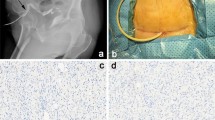Abstract
The conventional management of urogenital fistulas is surgical but a recent review of world data showed a high efficacy of hormonal manipulation by the induction of amenorrhea in the treatment of vesicouterine fistulas (VUFs). In fact, VUFs were first demonstrated to be hormonally regulated due to the fistulous canal being lined by endometrium. In this report, we suggest and discuss that, in women of reproductive age, the phenomenon of hormonal regulation is likely to be present in other fistulas communicating with the uterus, like ureterouterine and enterouterine fistulas.
Similar content being viewed by others
References
Józwik M, Józwik M (2000) Clinical classification of vesicouterine fistula. Int J Gynaecol Obstet 70:353–357
Rubino SM (1977) Medical treatment of utero-vesical fistula. Lancet i(8017):900
Józwik M, Józwik M (1998) Hormonal dependence of vesicouterine fistulas. Ginekol Pol 69:717–720
Józwik M, Józwik M (1999) Spontaneous closure of vesicouterine fistula. Account for effective hormonal treatment. Urol Int 62:183–187
Hemal AK, Wadhwa SN, Kriplani A, Hemal U (1994) Youssef’s syndrome: an appraisal of hormonal treatment. Urol Int 52:55–57
Issa MM, Schmid H-P, Stamey TA (1994) Youssef’s syndrome: preservation of uterine function with subsequent successful pregnancy following surgical repair. Urol Int 52:220–222
Nelson SK, Nelson S (1977) Congenital utero-vesical fistula: a case report. East Afr Med J 54:507–509
Jozwik M, Jozwik M, Sulkowska M, Musiatowicz B, Sulkowski S (2004) The presence of sex hormone receptors in the vesicouterine fistula. Gynecol Endocrinol 18:37–40
Zieba Z, Kaczmarek J (1989) Endometriosis of the bladder and vesico-uterine fistula as complications of cesarean section. Ginekol Pol 60:297–299
Lazarevski MB, Badiev B (1996) Obstetric ureterouterine fistula: a case report. Am J Obstet Gynecol 174:1657–1658
Lodh U, Kumar S, Arya MC, Tyagi A (1996) Ureterouterine fistula as a complication of an elective abortion. Aust N Z J Obstet Gynaecol 36:94–95
Kaban FR, Khundad SS, Al-Bahrani ZR (1981) Colo-uterine fistula. An unusual case report and a literature review. Am J Proctol Gastroenterol Colon Rectal Surg 32:36–40
Shaw FM, Reinus JF, Leikin EL, Tejani N (1995) Recurrent chorioamnionitis and second-trimester abortion because of an enterouterine fistula. Obstet Gynecol 86:639–641
Singh RB, Pavithran NM, Parameswaran RM, Sangwan K (2005) Chronic jejuno-uterine fistula: an unusual cause for recurrent second trimester abortions. Aust N Z J Obstet Gynaecol 45:533–534
Józwik M, Józwik M, Szamatowicz M (2003) Female fertility and the presence of urine in the genital tract: a brief appraisal. Int J Gynecol by Fax; II No. 31
Le Mer A (1968) Fistule vésico-utérine après basiotrypsie. Cure chirurgicale. Guérison (à propos d’un cas). J Urol Nephrol (Paris) 74:481–483
Molina LR, Lynne CM, Politano VA (1989) Treatment of vesicouterine fistula by fulguration. J Urol 141:1422–1423
Shafik A (1996) Non-surgical repair of rectovaginal fistulae. Eur J Obstet Gynecol Reprod Biol 67:17–20
Author information
Authors and Affiliations
Corresponding author
Rights and permissions
About this article
Cite this article
Józwik, M., Józwik, M. Hormonal dependence of fistulas communicating with the uterus. Int Urogynecol J 18, 719–720 (2007). https://doi.org/10.1007/s00192-007-0311-2
Received:
Accepted:
Published:
Issue Date:
DOI: https://doi.org/10.1007/s00192-007-0311-2




